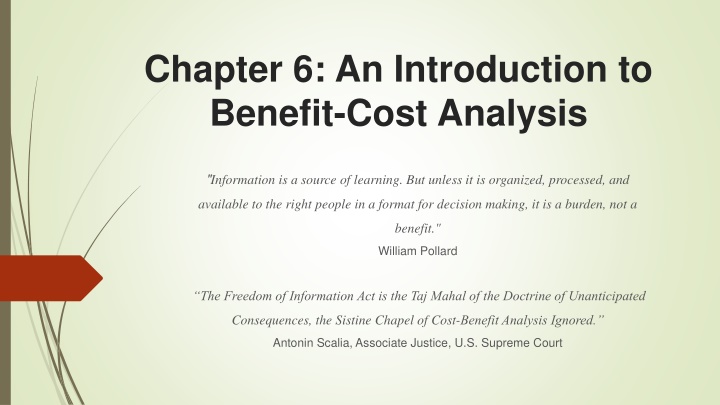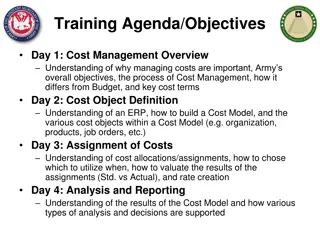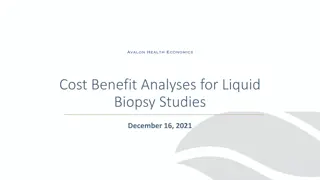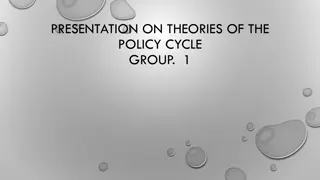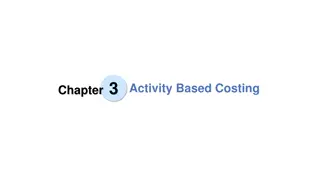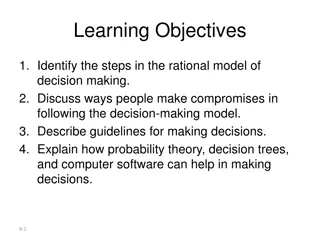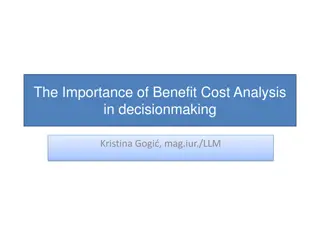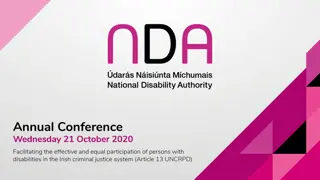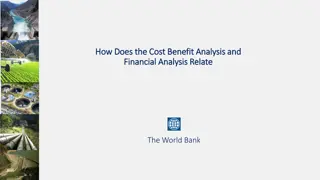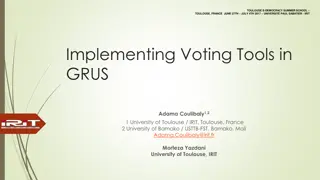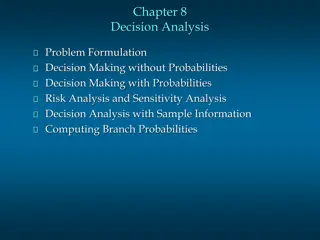Overview of Benefit-Cost Analysis in Policy Decision Making
This chapter delves into benefit-cost analysis as an essential tool in policy evaluation. It outlines the steps involved in conducting a benefit-cost analysis, emphasizes the significance of defining and quantifying policy problems, and highlights the importance of identifying the seriousness of social and economic issues. The chapter also introduces related decision models like cost-effectiveness analysis and weighted benefit-cost analysis, offering insights into assessing and comparing policy alternatives effectively.
Download Presentation

Please find below an Image/Link to download the presentation.
The content on the website is provided AS IS for your information and personal use only. It may not be sold, licensed, or shared on other websites without obtaining consent from the author.If you encounter any issues during the download, it is possible that the publisher has removed the file from their server.
You are allowed to download the files provided on this website for personal or commercial use, subject to the condition that they are used lawfully. All files are the property of their respective owners.
The content on the website is provided AS IS for your information and personal use only. It may not be sold, licensed, or shared on other websites without obtaining consent from the author.
E N D
Presentation Transcript
Chapter 6: An Introduction to Benefit-Cost Analysis "Information is a source of learning. But unless it is organized, processed, and available to the right people in a format for decision making, it is a burden, not a benefit." William Pollard The Freedom of Information Act is the Taj Mahal of the Doctrine of Unanticipated Consequences, the Sistine Chapel of Cost-Benefit Analysis Ignored. Antonin Scalia, Associate Justice, U.S. Supreme Court
Introduction This chapter introduces the process and decision rules for benefit-cost analysis. The chapter also introduces cost-effectiveness analysis, a decision model that can be useful when a full comparison of dollar-valued benefits and costs is not possible or not desirable. Finally, the chapter presents a related model labeled weighted benefit cost analysis, which allows the analyst to assign different values to different affected groups. One application of these weights involves assigning higher values to the net benefits of the poor.
Reviewing the Steps in a Benefit-Cost Analysis Let s review Eugene Bardach s 8 step process for policy analysis: (1) define the problem, (2) assemble evidence, (3) select criteria for making the decision, (4) identify the policy alternatives to be considered, (5) predict the outcome of each alternative, ( 6) confront the tradeoffs, (7) make recommendations, and (8) tell your story. The primary focus of this chapter is on steps 3 through 7, but a brief review of the process of defining and quantifying a policy problem may also be useful.
Identifying the Problem The goal of most public policies is to reduce, eliminate, or prevent a particular social or economic problem. Therefore, any convincing policy analysis should have clear and detailed answers to a seemingly simple set of questions: What is the problem? When, where, and how often does the problem occur? What are the causes of the problem? How serious are the harms caused by the problem?
Identifying the Problem Identifying the seriousness of the problem involves quantifying both the number of people affected by the problem and the intensity of harm suffered by those people. Some problems such as violating speed limits are very widespread but on average not very harmful. On the other hand problems such as homelessness, airline fatalities, or childhood cancer are comparatively rare but are very serious for their victims. Estimating the frequency of a given problem usually requires broadly based statistics. For national problems in the U.S. the federal government is usually the first place to search for statistical data. Quantifying the harms of the problem often involves complex economic, statistical, and interdisciplinary analysis. Examples will be considered throughout this book.
Assembling Information and Evidence In order to understand any policy problem, careful consideration of the academic and professional literature relating to this problem is important. For most people research now begins with a search of electronic sources such as on-line library catalogs and databases of academic or professional literature. Different university library systems have different sets of resources for research, so your professor and library staff may be important in setting up assignments for researching a policy topic.
Select the Criteria for Making the Decision The most common economic rule for analyzing policy alternatives is the Kaldor- Hicks criterion or fundamental rule of policy analysis discussed in Chapter 4. This rule leads the analyst to rank projects according to their total net benefits, or total benefits minus total costs. However, in policy areas such as health and safety policy a direct comparison of the dollar value of benefits and costs is controversial. In such cases policy analysis models such as cost-effectiveness analysis, which does not rely on a dollar value for lives saved, are sometimes used. Finally, when analyzing policies for which the distribution of income or other net benefits are important, relying on ethical criteria or assigning higher weights to the net benefits of the poor may be appropriate.
Identifying the Policy Alternatives In some cases several different policies might be used to address a problem. For example, traffic congestion (see Chapter 12) might be reduced through highway expansion, fees on rush hour drivers, regulations that encourage ride sharing, and subsidies for mass transit or other substitutes for the automobile. Different policies can be used either separately or in combination.
Marginal Analysis of Policy Decisions When quantity can be produced in small units and perfect information exists, we should continue to invest in a project as long as the marginal benefits of the project are greater than its marginal costs. Our optimal scale for the project will be where the marginal benefits and marginal costs are equal (See Figure 6-1).
Other Marginal Decision Rules Ideally, when one is choosing how much to spend on each of several policies or programs, she should allocate resources so that the marginal benefit for the last dollar spent for one project equals the marginal benefit of the last dollar spent on the other. In equation form, for any three projects X, Y, and Z, the ideal allocation of funds between the projects would occur where MBx MBy MBz = = (6-1) MCx MCy MCz This is basically the same formula as the utility maximization rule one sees in introductory microeconomics classes. If one has no budget constraint, each of these projects should be funded until its marginal benefits equal its marginal costs, as in Figure 6-1. If each project s marginal benefits equal its marginal costs, each ratio in equation (6-1) will equal 1.
Formulas for Comparing Benefits and Costs When information is not complete enough for marginal analysis, it is possible to compare the total or average benefits and costs of a policy using at least three different formulas, net benefits, the benefit/cost ratio, and the rate of return. Net Benefits = Total Benefits Total Costs Benefit/Cost Ratio = Total Benefits/Total Costs Rate of Return = 100% (Total Benefits-Total Costs)/Total Costs These measurements are sometimes consistent, but in others they can produce different rankings for alternative projects. In cases where these measurements are not consistent, a clear preference exists in economics for the net benefits measure as the best decision rule.
Your Turn 6-3: One design for new windmill complex costs $9 million to construct, will produce $15 million worth of power, and will require $2 million in operating and maintenance costs. A second design will cost $6 million to construct, produce $10 million worth of power, and will require $2 million in operating and maintenance costs. Find the net benefits, benefit/cost ratio, and percentage rate of return on each of these two projects. Project 1: net benefits = ____ benefit/cost ratio = ____ rate of return=____ Project 2: net benefits = ____ benefit/cost ratio = ____ rate of return=____ Which option is best according to each measure?
Accepting or rejecting a single project This situation has two variants, accepting or rejecting one project or separately considering each of a series of projects. The decision rule in this case is very simple. Approve the project if the net benefits are greater than zero, so that society experiences a net gain in well-being. If total benefits are greater than total costs, then the benefit/cost ratio will be greater than one and the rate of return will be greater than zero. All these outcomes will lead the analyst to recommend approval of the program. Your turn 6-5: Would you recommend building the wind farm project in Your Turn 6-3 above? Why or why not?
Choosing One of Several Possible Projects This type of situation occurs when determining the best use of a plot of land or a particular choice among competing designs for a building or highway project. The recommended rule for this decision is to choose the project with the highest net benefits. Rank these alternatives in terms of their net benefits. Then calculate the benefit cost ratio and rate of return for each alternative. Note that the benefit/cost ratios for the industrial park and the outlet mall are not consistent with the net benefit ranking. HOUSING INDUSTRIAL OUTLET MALL $1,600,000 $1,000 $1,200,000 $1,000 VACANT LOT PARK Benefits Costs Net Benefits B/C ratio Rate of Return $1,000,000 $1,250,000 $1,100,000 $900,000
Choosing an Optimal Budget An optimal budget is one that maximizes possible net gains to society as a whole. Therefore an optimal budget will fund all projects with positive net benefits for society. If marginal analysis is possible, an optimal budget would be sufficient so that each project or department is funded to the point where its marginal benefits equal its marginal costs, so that each ratio in equation 6-1 will equal 1.
Choosing Which Projects to Fund Within a Fixed Budget Making this choice involves the following steps. Calculate the benefit/cost ratio for each choice. Immediately reject any project which does not have a B/C ratio greater than one. Rank the projects according to their Benefit/Cost ratio. Choose the highest B/C ratio, then the next highest, and so forth until you cannot go further without breaking your budget. If you must skip one or more projects due to budget considerations, choose the remaining programs with the highest benefit/cost ratios that fit into the budget.
Your Turn 6-8: Assume that you have plenty of available land but only $3 million to spend. Following the 4 steps above, choose the projects from the following table that should be approved within this budget. Then verify that these projects provide the greatest total net benefits. Now assume that your budget has not been determined. Calculate the optimal budget for land development given these possible projects. Table 6-2: Project Choices Given a Budget HOUSING INDUSTRIAL PARK $1,000,000 $1,250,000 $1,600,000 $1,500,000 $4,200,000 $1,100,000 $900,000 $1,200,000 $900,000 $3,000,000 Net benefits OUTLET MALL GOLF COURSE POWER PLANT VACANT LOT $1,000 $1,000 Benefits Costs B/C ratio
Choosing the Scale of a Policy with Limited Information See Table 6-3 below. In 2001 the Environmental Protection Agency chose one of the following maximum allowable levels of Arsenic. Which one would you choose, if any, and why? Table 6-3: Alternate Arsenic Standard Benefits and Costs ARSENIC STANDARD 3 PPB Compliance Costs (millions of 1999 $) Estimated Health Benefits (millions of 1999 $) Cancer Cases Avoided 57-138 Source: U.S. EPA, 2001 5 PPB 10 PPB 20 PPB $698-792 $415-472 $180-206 $67-77 $214-491 $191-356 $140-198 $66-75 51-100 37-56 19-20 If half the cancer case resulted in death, and each life saved by the standard is assumed to be worth $6 million dollars, recalculate the health benefits and consider the choices again. Which level of arsenic would be chosen now? The answer may depend on which number of cancer cases you choose.
Choosing an optimal scale and allocation among different groups The analysis of this issue of both total scale and allocation involves several steps, displayed graphically in Figure 6-2. First one needs to calculate the marginal benefits of a given program for various groups. Then one adds the marginal benefit curves horizontally to find the marginal benefits of the total budget. One then finds the quantity where the sum of the marginal benefits meets the marginal cost (Qtotal), as well as the dollar value of the marginal cost at this quantity. So far we have determined the optimal scale.
Allocating an Optimal Budget Across Different Programs In order to allocate the budget efficiently across the two programs one should set the marginal benefit curve of each program equal to the dollar value of the marginal cost of the last unit produced. The quantities at which the individual marginal benefits equal this marginal cost dollar value (Q1and Q2) are the optimal quantities that should be allocated to each program. One might also notice that if MB1= MCtotaland MB2= MCtotal, this result also meets the marginal rule for an optimal budget in equation 6-1.
Benefits and Costs Using Efficiency Concepts
The Net Benefits of an Output Tax on Polluters The previous chapter contained an example of the effects of a tax on a polluting industry. Because this policy leads to higher prices and lower output, consumer surplus falls. Because the firm experiences lower output and lower after-tax revenue per unit, producer surplus also falls. The government and those experiencing external harm from the pollution benefit from the policy. The net benefits of this policy are most easily found by calculating the change in the surplus of each group and then adding the net effects.
The Net Benefits of an Output Tax on Polluters The net benefit of imposing the pollution tax equals $101.25, which equals the original value of the deadweight loss that was eliminated by the tax. The net benefits to both consumers and producers are negative, while the government and the outsiders suffering harm from the pollution gain. In principle, the winners could compensate the losers, but according to the Kaldor- Hicks criterion this is not required. Table 6-4: Net Benefits to Different Stakeholders CONSUMER SURPLUS SURPLUS SURPLUS $1,012.5 $1,012.5 $648 $648 -$364.5 -$364.5 PRODUCER EXTERNAL GOVERNMENT SURPLUS $0 $648 $648 TOTAL NET GAINS $1,518.75 $1,620.00 $101.25 Before tax With tax Difference= net benefits of tax -$506.25 -$324 $182.25
Cost-Effectiveness Analysis For some policies, the benefits of a policy are not directly measured in terms of money either because no monetary values have been estimated or because the analyst cannot or will not use monetary values to measure the benefit. Weighing of costs and benefits when benefits are not measured in dollars is referred to as cost-effectiveness analysis. The primary measurement tool in such studies is the cost/effectiveness ratio. Definition: Cost-effectiveness ratio = total cost/total non-monetary effect. The basic decision rule for this formula is to choose the alternative with the lowest cost per unit of effect.
Cost Effectiveness Analysis under Ideal Conditions Cost-effectiveness analysis can work reasonably well as a policy tool if it is used to compare policy alternatives with either equal total costs or equal total effects.
Example: The COPS program In 1994 Congress passed President Clinton s Community Oriented Policing Services (COPS) program, which added 100,000 officers to police departments. Assume that this goal can be accomplished by offering grants to local law enforcement agencies or by opening a national police training center. Salaries and training costs are $5,000,000,000 for each program. The training center costs $100,000,000 to build and maintain. The grants include $10,000,000 in expected waste and fraud, and also include $10,000,000 in administrative costs. Given these assumptions the total cost of the training center is $5,100,000,000 ($5.1 billion) and the total cost of the grants equals $5,020,000,000 ($5.02 billion). Therefore the cost per officer (the cost/effectiveness measure for this scenario) = $5,100,000,000/100,000 or $51,000 for the training center and $5,020,000,000/100,000 = $50,200 for the grants. The grants are more cost effective and would be recommended.
Cost Effectiveness Under Less Than Ideal Conditions If two alternative policies have unequal effects and unequal total costs, cost-effectiveness analysis is less reliable as a decision tool. Let s begin with an example and then analyze the limits of this approach. Example: S. Lumlord owns 50 apartments that are infested with cockroaches. There are two methods of combating cockroach infestation, spraying and setting traps. Spraying costs $25 per apartment and is 80 percent effective in eliminating roaches in any single apartment. Setting traps costs $10 per apartment, but is only 40 percent effective in ridding each apartment of roaches. Assuming that we measure effectiveness as the number of roach free apartments, which method should Mr. Lumlord use?
S.Lumlord continued The cost of spraying is $25 50 apts., or $1,250, while traps cost $10 50 or $500. There will be 50 0.8, or 40 roach free apartments after spraying and 50 0.4, or 20 roach free apartments using traps. The cost effectiveness ratios are $1,250/40 ($31.25/bug free apt.) for spraying and $500/20 ($25/bug free apt.) for traps. According to this measure, traps cost less per roach-free apartment, and are more cost- effective.
Problems With Cost-Effectiveness Analysis This type of cost-effectiveness problem seems obvious enough, but some important issues are unresolved. First, there are 30 roach-infested apartments remaining after using traps but only 10 remaining after spraying. Also, we have no way of knowing from cost effectiveness estimates how much more valuable the apartments will be if they are roach-free, or how that value affects the total benefits of each method. It is quite possible that the added value of the extra 20 roach free apartments after spraying would justify the added expense, but we cannot address this issue with cost-effectiveness analysis.
Weighted Net Benefits Assigning higher weights to the net benefits flowing to disadvantaged groups can be easily justified on equity grounds and in a more limited way on efficiency grounds as well. The primary reason for weighing dollar valued net benefits to the least well- off more highly is because the usual cost benefit calculation ignores the declining marginal utility of consumption, an issue that was discussed at length in Chapter 3. Other ethical theories may assign very different weights to the net benefits of different groups. To take the most extreme example discussed in Chapter 3, John Rawls difference principle, taken literally, would assign all of the weight to the net benefits of the least well-off person.
Conclusion This chapter introduced the basic economic tool for the analysis of public policy, benefit-cost analysis, along with some related analytical tools. The key elements of the chapter included the rules for various types of policy decisions, the introduction of cost-effectiveness analysis for situations in which either the benefits or costs cannot be quantified in dollar terms, and the consideration of different weights for the net benefits of different groups. Benefit-cost analysis and all of its related models are best thought of as tools for organizing one s thoughts and evidence about a policy s effects, particularly its efficiency effects. It does not actively consider equity, political practicality, or other policy goals.
Kaldor-Hicks versus Ethical Income Transfers In Figure 6-4, the Kaldor-Hicks criterion weighs all incomes equally, so that a neutral redistribution of net benefits doesn t matter. The utilitarian graph in Figure 6-4 displays social indifference curves that are curved because of the declining marginal utility of income for both persons. Equality is preferred given equal tastes.
Kaldor-Hicks versus Ethical Income Transfers In Figure 6-5 transfers are non-neutral. In this case no income redistribution is justified under the Kaldor-Hicks criterion, while a modest amount of redistribution is prescribed by utilitarianism and near equality is preferred according to the Rawlsian social welfare function.
A Weighted Net Benefits Example A modified form of Feldstein s (1974) model is presented in the following Y median Y = equation. weight where = the marginal social utility of income and Yi is the i income level of a particular group.Table 6-6 displays the weights produced by this formula for a few values of alpha ( ). Table 6-6: Distributional Weights Using the Feldstein Formula Unweighted Income ( =0) 20,000 1 40,000 (median) 1 60,000 1 Weight weight ( =1/2) 1.414 1 .8165 weight ( =1) 2 1 2/3
Your Turn 6-13: A training program provides total net benefits of $100,000 to a group of disadvantaged youth. The program costs $120,000. The median income in this society is $40,000. The youth have average incomes of $10,000, while those paying for the program have average incomes of $80,000. Calculate the weights for the $10,000 income group and $80,000 income group using Feldstein s formula, then calculate the weighted benefits and costs for each group and determine the net benefits using each weight. Table 6-7: A Weighted Net Benefits Example Weight ( =0) Weight ( =1/2) Weight ( =1) $10,000 weight $80,000 weight Weighted benefits to poor youth Weighted costs to quiche eaters Weighted net benefits of program
